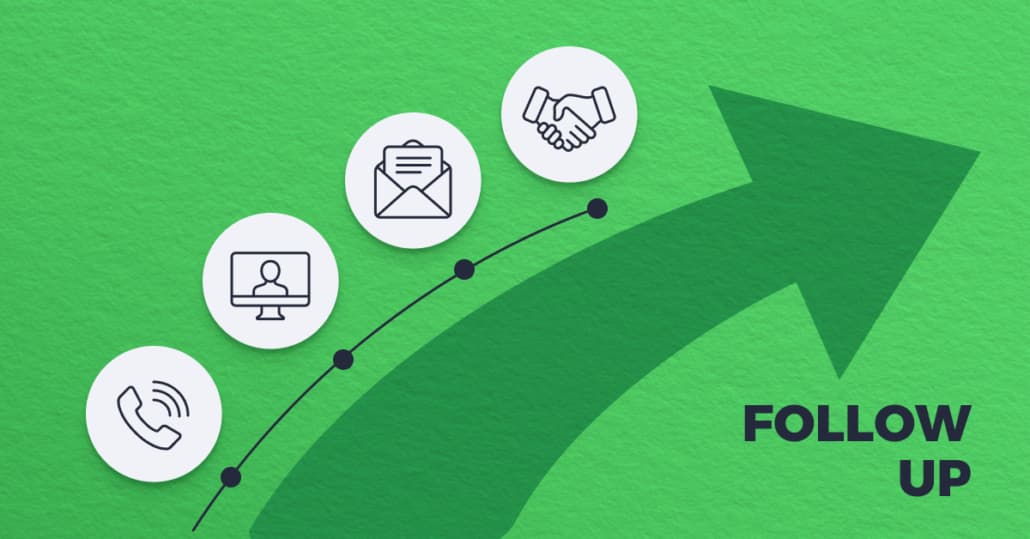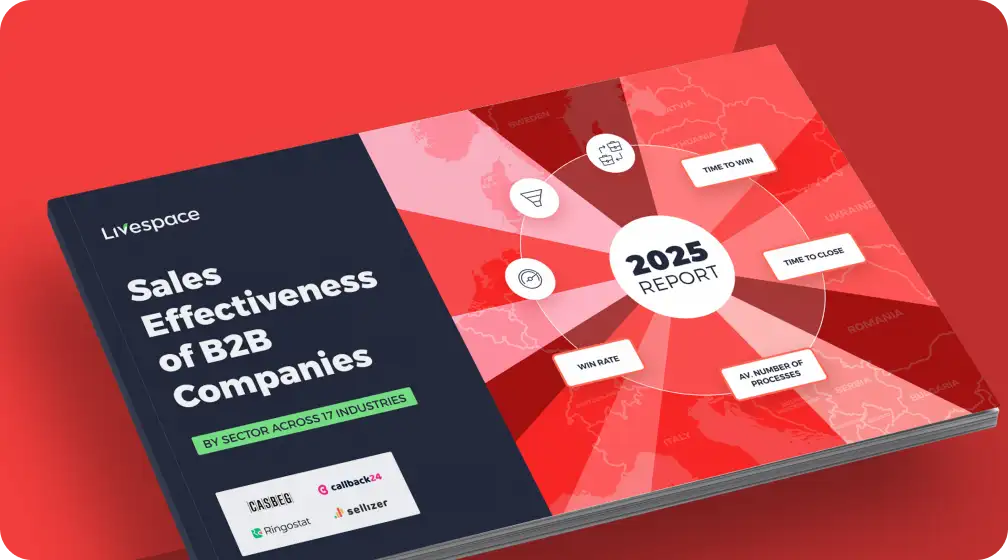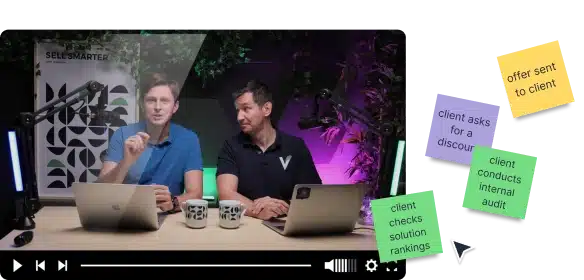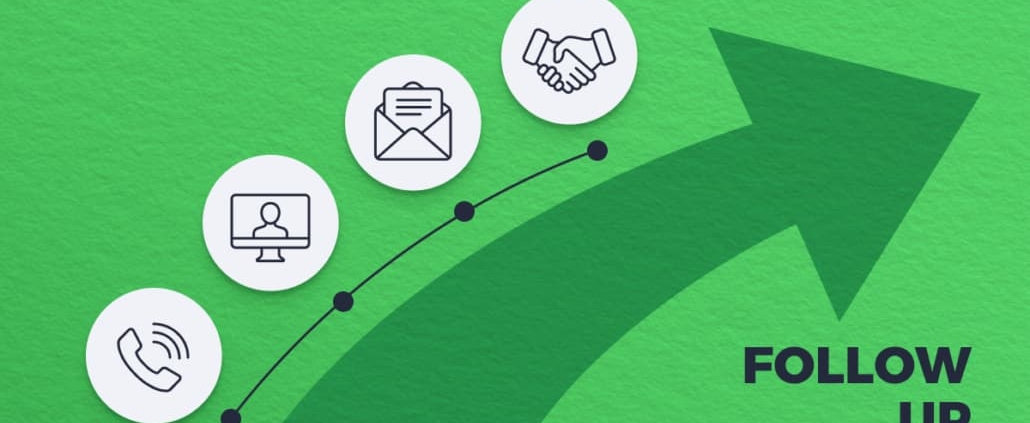How to Carry out an Effective Follow-up Email? Ready-to-use Follow-up Email Templates

We’ve all received (and probably sent) those generic follow-ups that start with “Just checking in…” or “Following up on my previous email…” – and we all know how easy they are to ignore, especially when paired with poor email subject lines. It sounds generic, lacks urgency, and offers no value to the recipient.
The truth is, that a weak follow-up can kill a potential deal, while a well-crafted one can significantly boost your chances of closing.
In this article, we present foolproof tips for creating an effective follow-up. At the end, you will find 12 ready-to-use templates for writing professional follow-up emails that will help you close the deal.
Why writing a follow-up email is important
Writing follow-up emails doesn’t have to be awkward – you just have to learn how to do it right. A follow-up proves that you care and gets your conversation back on track. It helps dispel doubts, handle customer objections, and increase your chances of winning a sale. Some people close even more than 75% of the deals thanks to it.
Studies show that 48% of salespeople never follow up, while 80% of sales require at least five follow-ups. Sending a follow-up email is essential for maintaining professional relationships, ensuring clear communication, and increasing response rates. Using a clear and professional follow-up email format is crucial for maintaining professional yet engaging relationships with clients. Whether you’re reconnecting after a meeting, checking in on a proposal, or writing an email after no response, it’s crucial to craft a polite follow-up email that helps you keep the conversation going.
Creating a follow-up email strategy is crucial to help you organize email communications with clients. A structured approach ensures emails are planned and ready to send. It also allows you to move prospects through the sales funnel more effectively. Creating a strategy also ensures your follow-ups are aligned with your sales methodology and process. Having planned follow-ups also increases conversion chances by addressing objections, providing additional information, and keeping your solution top of mind.
5 tips on how to write perfect follow-up emails
A follow-up email isn’t just a reminder – it’s an opportunity to reignite interest, provide value, and move the conversation forward to boost sales win rates. To make your follow-ups effective, you need the right timing, a compelling subject line, and a clear purpose. Below, we’ll break down the key elements of a high-converting follow-up email and share proven strategies to boost response rates.
Choose the right time to write a follow-up message
First, make sure once again that the customer has not replied. It is easy to miss an email response if your inbox is full of messages.
The second key issue is: when to send the follow-up. If we have already managed to establish contact, we should always act as quickly as possible, but without too many follow-ups. A gentle reminder can be used in follow-up emails to prompt recipients about previous communications or unpaid invoices, conveying a supportive tone while encouraging a response.
Here are the suggested time frames to write follow-up emails:
24 hours – After an email or meeting. Remember to attach the promised materials.
48 hours – After sending an offer.
Research shows that the first company to reach a customer secures the sale 35-50% of the time – source: Fronetics
1–2 weeks – Email after no response to the offer.
Every 3 months – To maintain the relationship.
Create a strong subject line
A clear subject line is essential as 47% of emails are discarded based on it. Make it easy for the recipient to understand the purpose of your email at a glance. A clear, concise subject line can increase the chances of your email being opened.
Avoid using buzzwords and ambiguous language, it doesn’t provide the recipient any context. Make the purpose of your follow-up email very clear, so the prospect understands immediately the reason you contacted them.
The best subject line is also only as long as it has to be. So, make it compelling in as few words as possible. Most people read emails on mobile devices, so the number of characters is limited.
Here are some examples of email subjects that can increase the open rate:
1. A closed-ended question (one that can be answered yes or no)
e.g. Do you have time for a short call tomorrow?
2. A compliment (doesn’t everybody like them?)
e.g. Great presentation at the Pipeline Summit!
3. A subject containing the name
e.g. Martin, how do you increase the effectiveness of the team?
4. One proving that you have done research
e.g. And you know that you are running a start-up when…
5. One interrupting the silence
e.g. Are you still interested in our offer?
6. A quick call suggestion
e.g. Can we schedule a quick call to discuss new solutions?
Specify the reason for the contact
Provide context to the email by mentioning when you last spoke or interacted. Referencing previous emails can help the recipient remember you. Clearly defining what you want from the person you’re contacting will help you craft a strong and effective call to action later on.
Here are some examples of the reasons for sending a follow-up:
1. Acquisition of information
When we want to clarify something or ask about the status of the decision.
2. Arranging a meeting
After an initial conversation, we can propose a face-to-face meeting or an online presentation.
3. Summary of a meeting
When we want to sum up an already-held meeting and propose further steps.
4. Maintaining the relationship
When we want to congratulate the customer on the success we have heard about, or ask for feedback and propose optimization.
In the introduction, refer to a specific situation
Provide context to the email by mentioning when you last spoke or interacted. We much better remember messages that build a relationship and refer to a personal context – and it is worth starting the email with just that. Not only will such an email get etched in the customer’s memory, but it will also make it harder for him or her not to respond to it. Learning how to write a follow-up email effectively is crucial for creating engaging introductions that prompt responses.
Here are some examples of how to begin a follow-up well:
- I got your contact information from our common friend…
- I heard your presentation at…
- Last week we had the opportunity to meet at the conference…
- A few days ago we spoke on the phone about…
State the purpose of the message clearly
Always bear in mind that the recipient of your message is probably very busy. Respect their time and tell them clearly why they should devote it to you. State the exact reason for contact and never create a mysterious background to the topic of the proposed meeting. Writing follow-up emails strategically is crucial; start with a polite greeting, reference previous communications, and state the purpose of your email right away.
“Hi, I would like to talk about your business” really does not contribute much.
Instead, say: “Hi, I would like to present a strategy for communication on Quora that will help you position your product.”
Another example: “We are organizing a meetup I would like to invite you to – the workshop section will focus on the improvement of the indicators on which you are certainly working at [company name].”
P.S. We really organize such meetups.
Provide a clear call to action
A great follow-up email should guide the recipient toward the next step without any confusion. Instead of leaving the conversation open-ended, be direct about what you want them to do—whether it’s scheduling a call, reviewing a proposal, or providing feedback.
Here are some key tips for crafting an effective call to action:
- Be Specific – Instead of saying “Let me know what you think,” try “Can we schedule a 10-minute call on Tuesday at 2 PM?”
- Make It Easy – Offer a clear action, such as clicking a link to book a meeting or replying with a simple “yes” to confirm interest.
- Create a Sense of Urgency – Phrases like “Spots are filling up fast” or “This offer is available until Friday” can encourage quicker responses.
- Keep It Short – Your call to action should be one sentence, making it easy to understand and act on.
Example: “Would you be available for a quick 15-minute call on Thursday at 11 AM, or would another time work better?”
Providing a clear and actionable next step can help you increase the chances of keeping the conversation moving forward and closing the deal.
Add other people to the message (CC)
This point applies when more than one interlocutor is involved in the conversation at any stage. In such a case, all these people (especially the decision-makers) should be added to the CC field of the email.
A study published by Yesware shows that recipients respond to emails 12% more often if other people have been included in the message.
– source: Yesware
If others know that some activities are under way, it is more difficult to ignore them. What is more, if there are other recipients in the CC field of the email, we automatically assume that the matter is important. So, there is a good chance that at least one person will get involved in the thread, including the decision-makers.
Common Mistakes to Avoid in Follow-up Emails
While follow-up emails can be an effective way to re-engage leads and move opportunities forward, there are several common mistakes to avoid:
- Sending too many follow-up emails: Bombarding recipients with too many follow-up emails can be seen as spammy. It’s important to find the right balance and avoid overwhelming your audience.
- Not personalizing emails: Failing to personalize follow-up emails can lead to lower response rates. Personalization shows that you have taken the time to understand the recipient’s needs and can make your emails more engaging.
- Not providing value: Follow-up emails should provide value to the recipient, whether it’s additional information, a special offer, or a solution to a problem. If your follow-up emails lack value, recipients are less likely to respond.
- Not optimizing subject lines: Subject lines determine whether an email is opened or not. Long and mysterious subject lines can lead to lower open rates. Make sure your subject lines are clear, concise, and compelling.
- Not tracking results: If you don’t track the results of follow-up emails you won’t be able to tell if they are effective. Use analytics to monitor metrics like open rates and click-through rates to refine your follow-up strategy. Align your email strategy with sales metrics to drive even more data-backed results.
By avoiding these common mistakes, you can create more effective follow-up emails that engage your audience and drive better results.
Follow-ups in sales – 12 effective follow-up email templates
Let’s move on to concrete examples. Here are 12 ideas for reminder emails that you can use right away and suggest to your team.
Treat a follow-up email template as a strong starting point – in each case it is worth editing them a little bit, adjusting the style and form of the message to the individual customer or industry.
1. Application: After downloading content
Did you find our e-book [name of the material] useful?
Hi [name],
I’ve noticed that you recently downloaded our e-book [name of the material]. People who download it are usually interested in [reason for downloading in relation to the features of your product].
I am not 100% sure if our platform will address your needs, but, in order to better explain how it works, I have attached a case study on a company in your industry:
[link to the case study]
If the material turns out to be interesting, maybe I could propose a short on-line presentation during which we will verify together whether this solution will work in your company?
Kind regards,
[footer]
2. Application: After a meeting
I thought this too might interest you
Hi [name],
Thank you very much for devoting your time to today’s meeting. It was really nice to learn more about the specific nature of your business and talk about your experiences in [the field].
You mentioned that a new manager at your company was looking for a way to [name of the problem].
We have recently written extensive material on this subject: [link to the content]
You can forward it to the manager or, maybe, it will be useful to the other members of the team.
Thank you again for your time. Good luck with [the raised topic] and I hope we will stay in touch!
Kind regards,
[Footer]
3. Application: Immediately after leaving a voice mail message.
I couldn’t get through to you
Hi [name],
I called a moment ago to [the purpose].
In the voicemail message, I mentioned that I would try again on [day], but I’d like to add that you can call me back at your convenience or ask me additional questions by email.
Kind regards,
[Footer]
4. Application: After a conference, fair, or meetup
Great presentation at [name of the event]!
Hi [name],
Your presentation at [name of the event] made a huge impression on me. Congratulations!
It taught me a lot about [the subject raised].
It seems that our companies have a similar target group. I thought you might be interested in our partner program.
[link]
Let us know if you see the scope for cooperation too.
Kind regards,
[Footer]
5. Application: A follow-up to the first attempt at contact
[Name], do you have any additional questions regarding my message?
Hi [Name],
I hope you got a chance to read my previous email and look at our website. So, I thought it was a good idea to contact you again and ask about your observations.
Have you considered my proposal? When would you find 5 minutes for a phone call so that I could answer any questions you may have?
Kind regards,
[Footer]
6. Application: A follow-up to the first conversation
It was nice talking to you, [name].
Hi [name],
Thank you for the conversation today. I’m glad I was able to learn more about your role at [company name]. I understand very well the difficulties you face every day, and that [the type of a task] is quite a challenge.
As promised, I’m sending materials that may turn out to be helpful to you.
link 1
link 2
I’m also including information about how our tool can help you with [name of the problem] and to increase [name of the indicator].
If you have any questions, please let me know. I would be happy to arrange another meeting.
Kind regards,
[Footer]
7. Application: Repeated contact after a long period of time
Do you have any additional questions, [name]?
Hi [name],
During our last conversation, you asked that we discuss again, in a few months’ time, how [name of your company] can help you achieve your business goals.
I thought that the planning of a new quarter is a good time to get back to that subject.
Have you thought about our proposal? I would be happy to arrange a meeting (in person or on-line) and answer any additional questions that may have arisen.
Do you have any plans for this week?
Kind regards,
[Footer]
8. Application: The last follow-up after several attempts and no response
Should we delete your data?
[Name],
We are doing an end-of-the-month cleanup of the system, and deleting the data of people from whom we have not received a return message. Usually, when we do not receive an answer from someone, this means that this person is either very busy or simply not interested.
If you are not interested, can we delete your data from the system?
However, if the lack of response is due to another reason, then what will be the most convenient date for you to be contacted? I would be happy to answer any additional questions.
Kind regards,
[Footer]
9. Application: When it is difficult for you to identify the decision-maker
Version 1:
[Name], can I ask you a favor?
Hi [name],
I have contacted you several times to talk about what [name of your company] can do for your business. My guess is that you get at least a few messages like this one every day, and maybe you don’t entirely influence the decisions in this respect.
Therefore, I would like to ask you a favor. I would like to talk to the person in your company who is responsible for [name of department/operations] and will be the right one to talk to about [the offered benefit]. Could you tell me who that is?
However, if you are that person, when can I call you to discuss more details?
Thank you.
Kind regards,
[Footer]
Version 2, more official:
Good day,
It has just occurred to me that maybe the issue of [the subject raised] at [company name] is being dealt with by someone else and I am bothering you unnecessarily.
If so, I would be very grateful for the contact information of the person who is dealing with it directly. I do not suppose that I will take more than 15 minutes of their time, and if our approach turns out to suit your company, it may add a lot of value.
Kind regards,
[Footer]
10. Application: After a trial account has been created
First steps in [name of the system] – welcome to the trial version!
Hi [name],
Thank you for signing up for the best [type of system, e.g. CRM] for [the benefit, e.g., increasing the effectiveness of sales].
I’m your assistant who will help you to take full advantage of the trial period in [name of the system] and show how you and your team can [benefit].
First, log in and configure the basic account settings.
Here [link] you will find out how to do that.
If you have any questions, you can ask them in the response to this email or call me at any time at [number].
Kind regards,
[Footer]
11. Application: During the trial period
Make the most of the trial period in [name of the system]
Hi [name],
Below is a playlist of short videos that will help you make the most of your trial period in [name of the system].
link 1
link 2
link 3
Below are other useful resources:
a link to the knowledge base
I will be happy to personally guide you through the system configuration process. Do you have a few minutes for a phone call or a short on-line demo this week?
Kind regards,
[Footer]
12. Application: During the trial period, email 2
Your sales command center
Hi [name],
Let me know if you have any questions about using [name of the system]. I know there are a lot of features, so let me know if I can help.
I will also be happy to show you, in person, how to best configure the system for your individual needs. Will you have a few minutes for a short Skype conversation this week?
Kind regards,
[Footer]
Sounds better than “Just checking if”, doesn’t it? Always write follow-ups bearing in mind that they should have a decisive influence on the customer’s decision-making process. Clearly express the purpose of the message, talk about benefits, provide value, and propose the next steps.
We hope that our templates will help you increase the response rate.
Key Takeaways
Follow-up emails are an essential part of the sales process that help reconnect with potential clients. By avoiding common mistakes and using expert tips, you can create effective follow-up emails that re-engage leads, move opportunities forward, and improve customer satisfaction.
To send effective follow-up emails every time, keep in mind these key takeaways:
- Sending follow-up emails can increase response rates and move opportunities forward: A well-crafted follow-up email can prompt recipients to take action and help advance the sales process.
- Personalize emails and provide value: Tailoring your emails to the recipient and offering valuable content can boost engagement.
- Optimize subject lines and track results to determine the effectiveness of follow-up emails: Clear and compelling subject lines can increase open rates while tracking results help improve your strategy.
- Keep emails short and sweet, and use a clear and concise subject line to improve open rates: Respecting the recipient’s time and making your emails easy to read can boost their effectiveness.
- Use a polite and professional tone, and reference previous communication to help build trust and rapport with customers and prospects: A professional approach and acknowledging earlier messages can strengthen relationships and encourage responses.
By implementing these strategies, you can enhance your follow-up email efforts and achieve better outcomes in your email marketing campaigns.
Here is how Livespace can help you automate sales and the follow-up sending process:
- CRM integration with any email service
- support for email templates: a ready-made database and the ability to add more by copying and pasting
- planned sending of email sequences
- possibility of setting individual reminders, e.g., about the need to make a call
Other posts

Turning ‘No’ into ‘Yes’: How to Convince Your Customers to Buy from You?

Sell Wiser, Not Harder. 3 Key Steps to Master Sales Automation






